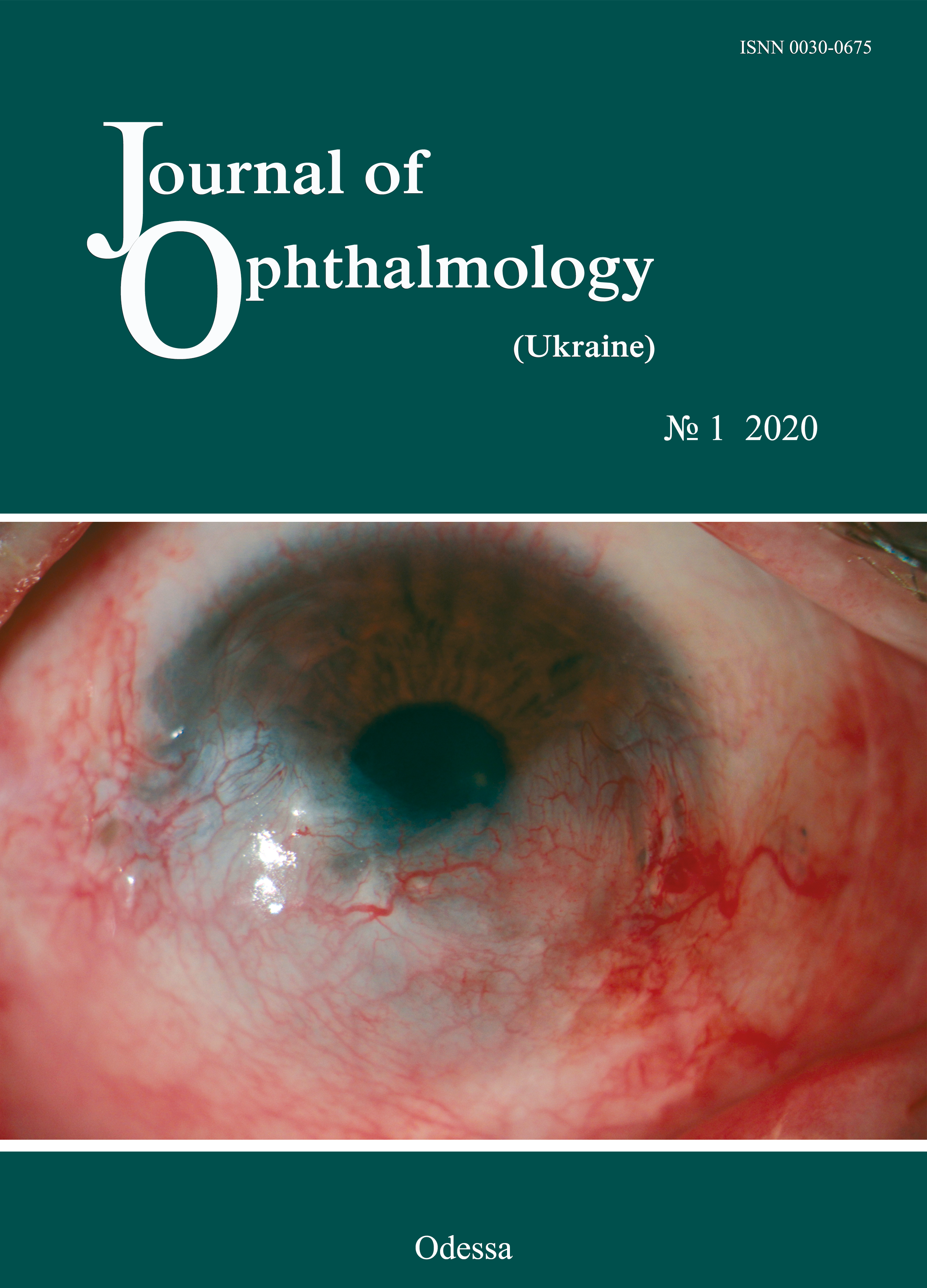Morphological features of the lamina cribrosa in patients with various degrees of myopia
DOI:
https://doi.org/10.31288/oftalmolzh202013234Keywords:
myopia, lamina cribrosa, optical coherence tomographyAbstract
Background: The lamina cribrosa plays an important role in the development of vision and undergoes changes as myopia evolves.
Purpose: To examine morphological features of the lamina cribrosa in high, moderate and low myopes vs generally healthy controls using optical coherence tomography (OCT)-derived markers.
Methods: Fourier-Domain OCT of the outer portion of the optic disc was performed in 40 low myopes (Group 1), 39 moderate myopes (Group 2), 41 high myopes (Group 3), and 20 generally healthy controls (Group 4) using an RTVue-100 instrument (Optovue Incorporated). The RTVue software version 6.11 was used to calculate the optic disc parameters based on the LC morphology markers we designed.
Results: Length of the line connecting the flanking edges of Bruch’s membrane, maximum LC depth, depth of the LC insertion, and length of the line connecting the margins of LC insertion were statistically significantly greater (p < 0.05) in patients than in controls. In addition, we found these characteristics to significantly increase with an increase in severity of myopia.
Conclusion: The lamina cribrosa is an important ocular structure and warrants further research for better understanding the pathogenesis of and prophylaxis against myopia.
References
1.Ng DS, Cheung CY, Luk FO et al. Advances of optical coherence tomography in myopia and pathologic myopia. Eye (Lond). 2016;30(7):901-916. https://doi.org/10.1038/eye.2016.47
2.Akagi T, Hangai M, Takayama K et al. Reproducibility of In-Vivo OCT Measured Three-Dimensional Human Lamina Cribrosa Microarchitecture. Invest Ophthalmol Vis Sci. 2012;53(7):4111-4119.https://doi.org/10.1167/iovs.11-7536
3.Nuyen B, Mansouri K, Weinreb RN. Imaging of the Lamina Cribrosa using Swept-Source Optical Coherence Tomography. J Curr Glaucoma Pract. 2012 Sep-Dec;6(3):113-9. https://doi.org/10.5005/jp-journals-10008-1117
4.Lee EJ, Kim TW, Weinreb RN, Park KH, Kim SH, Kim DM. Visualization of the lamina cribrosa using enhanced depth imaging spectral-domain optical coherence tomography. Am J Ophthalmol. 2011;152:87-95.e1.https://doi.org/10.1016/j.ajo.2011.01.024
5.Park SC, Kiumehr S, Teng CC et al. Horizontal Central Ridge of the Lamina Cribrosa and Regional Differences in Laminar Insertion in Healthy Subjects. Invest Ophthalmol Vis Sci. 2012; 53:1610-1616. https://doi.org/10.1167/iovs.11-7577
6.Omodaka K, Takahashi S, Matsumoto A et al. Clinical Factors Associated with Lamina Cribrosa Thickness in Patients with Glaucoma, as Measured with Swept Source Optical Coherence Tomography. PLoS One. 2016; Apr 21;11(4):e0153707. https://doi.org/10.1371/journal.pone.0153707
7.Xiao H, Xu XY, Zhong YM, Liu X. Age related changes of the central lamina cribrosa thickness, depth and prelaminar tissue in healthy Chinese subjects. Int J Ophthalmol. 2018;11(11):1842-1847. https://doi.org/10.18240/ijo.2018.11.17
8.Tan NYQ, Tham Y-C, Thakku SG et al. Changes in the Anterior Lamina Cribrosa Morphology with Glaucoma Severity. Sci Rep. 2019; 9: 6612. https://doi.org/10.1038/s41598-019-42649-1
9.Miki A, Ikuno Y, Asai T et al. Defects of the Lamina Cribrosa in High Myopia and Glaucoma. PLoS ONE. 2015;10(9):e0137909.https://doi.org/10.1371/journal.pone.0137909
Downloads
Published
How to Cite
Issue
Section
License
Copyright (c) 2025 П. А. Бездітко, А. О. Гуліда

This work is licensed under a Creative Commons Attribution 4.0 International License.
This work is licensed under a Creative Commons Attribution 4.0 International (CC BY 4.0) that allows users to read, download, copy, distribute, print, search, or link to the full texts of the articles, or use them for any other lawful purpose, without asking prior permission from the publisher or the author as long as they cite the source.
COPYRIGHT NOTICE
Authors who publish in this journal agree to the following terms:
- Authors hold copyright immediately after publication of their works and retain publishing rights without any restrictions.
- The copyright commencement date complies the publication date of the issue, where the article is included in.
DEPOSIT POLICY
- Authors are permitted and encouraged to post their work online (e.g., in institutional repositories or on their website) during the editorial process, as it can lead to productive exchanges, as well as earlier and greater citation of published work.
- Authors are able to enter into separate, additional contractual arrangements for the non-exclusive distribution of the journal's published version of the work with an acknowledgement of its initial publication in this journal.
- Post-print (post-refereeing manuscript version) and publisher's PDF-version self-archiving is allowed.
- Archiving the pre-print (pre-refereeing manuscript version) not allowed.












